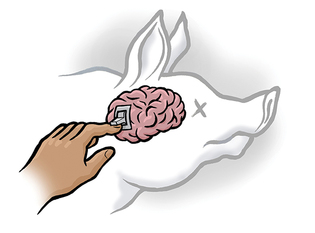 loading
loading
FindingsFrankenpig?Researchers trigger signs of life in a dead porcine brain.  Gregory NemecView full imageWhen blood flow to the brain is cut off by a heart attack, stroke, or trauma, there’s little time to restore circulation before irreversible damage occurs. Now, a provocative experiment by School of Medicine neuroscientist Nenad Sestan ’99PhD and his colleagues has shown that the brain may be far more resilient than previously thought. “The brain has an under-appreciated capacity to restore circulation and cellular activity,” says Sestan. “Cell death takes significantly longer than we thought.” The discovery has spurred ethical commentary on the gray zone between postmortem and living tissue, and ethicists are working to come up with guidance for the technology Sestan developed (which Yale has patented). Sestan’s team experimented on 32 pig brains extracted from animals slaughtered four hours earlier. For six hours, they pumped a chemical solution they had developed into the brains’ blood vessels. And they saw signs of cell viability and function. “We were able to restore and maintain circulation, the inflammatory function of glial cells was preserved, hippocampal neurons became spontaneously active when removed from the brain and blocking agents were washed out, and there was a resurgence in global metabolism,” says Sestan. (The research was published in Nature.) The brains were never clinically alive, however. “We never saw signs of the organized electrical activity and connectivity that we associate with consciousness,” Sestan notes. In part, this was deliberate, for the researchers added a blocking agent that prevented neurons from firing. At present, no one knows whether the patterns that indicate consciousness would form if the blocking agent were removed or if the experiment went on longer. Stephen Latham, the director of Yale’s Interdisciplinary Center for Bioethics, worked with Sestan’s team to ensure the study passed ethical muster. He has no doubt that such research will come—and that ethicists and regulators must develop an appropriate oversight framework while the technology is still in its infancy. The ability to keep an intact brain going in the lab will be invaluable for understanding its function and for testing new medicines, Latham says. One day, doctors may use Sestan’s technique to reverse stroke damage. And what about the future? Will the sci-fi specter of people living forever as brains in jars come true? “I don’t think many people would value a life of pure consciousness,” Latham says. The technology should be banned for such purposes, he adds. “Humans are not just their brains.”
The comment period has expired.
|
|